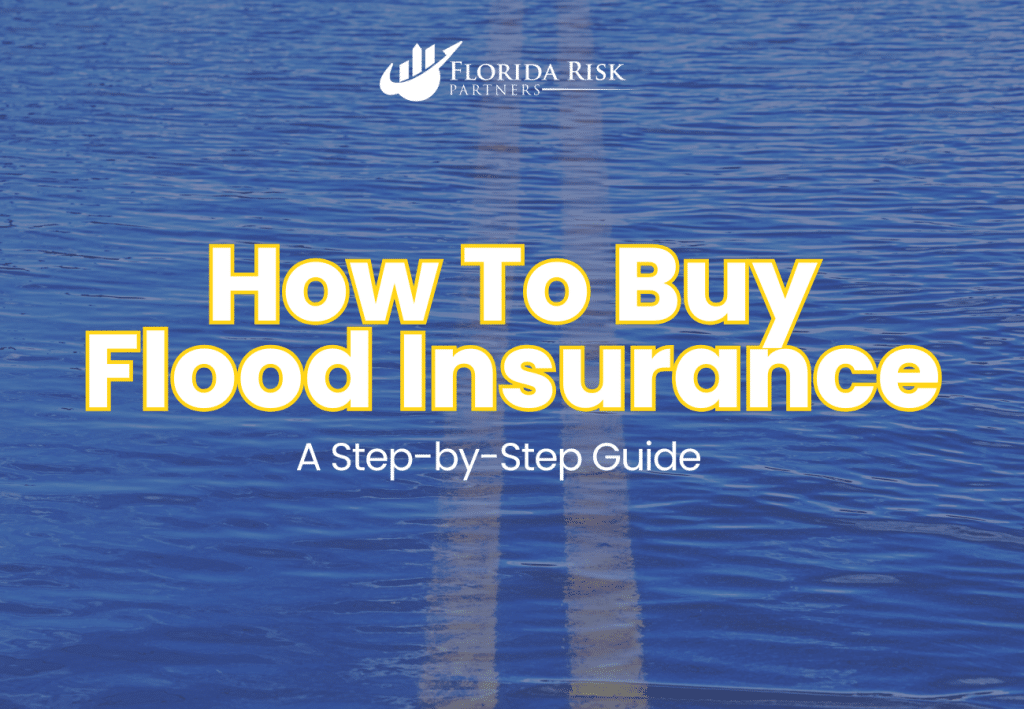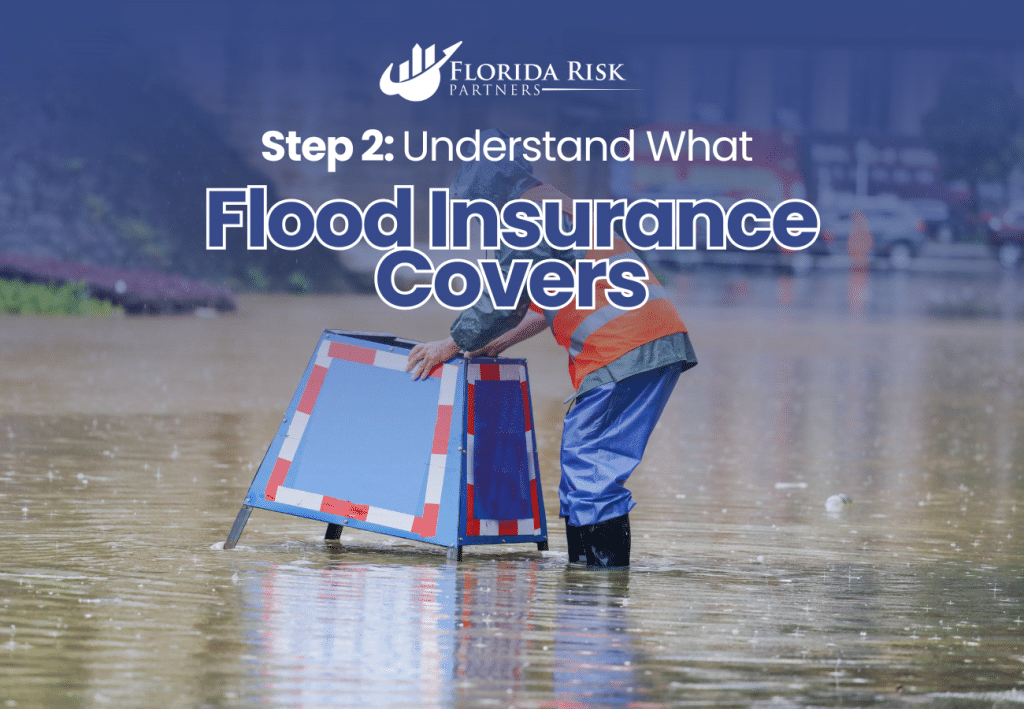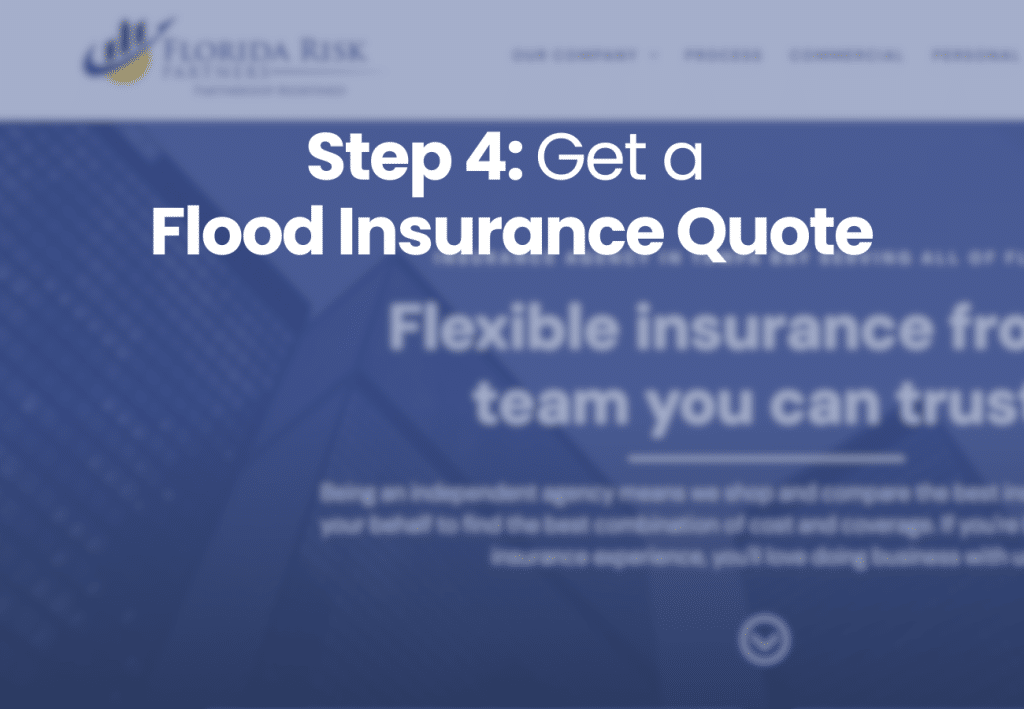-
Main Office: 1434 E. Bloomingdale Ave Valrico, FL 33596-6110
-
Phone: (888) 601-6660
-
Email: info@floridariskpartners.com

Flooding is one of the most common and costly natural disasters, yet many homeowners and business owners remain uninsured for flood damage. Whether you’re in a high-risk flood zone or a low-risk area, securing the right flood insurance policy is crucial for protecting your property and finances. However, navigating the process of buying flood insurance can be confusing, especially with the various options and factors that influence coverage.
In this post, we’ll walk you through a step-by-step guide on how to buy flood insurance. From determining your flood risk to choosing the right policy, this comprehensive guide will help you make informed decisions. As part of our Flood Insurance 101 series, this guide will ensure you have all the information you need to protect your home or business.
Step 1: Determine Your Flood Risk
The first step in buying flood insurance is understanding your property’s flood risk. FEMA assigns flood zones based on the likelihood of flooding, and this designation directly affects your insurance requirements and premiums.
- High-Risk Zones (Special Flood Hazard Areas – SFHAs): These are areas that have at least a 1% annual chance of flooding, often referred to as the “100-year floodplain.” If your property is in one of these zones (e.g., Zone A or Zone V), you are required to carry flood insurance if you have a mortgage from a federally regulated or insured lender.
- Moderate- to Low-Risk Zones (Non-Special Flood Hazard Areas – NSFHAs): Properties in these zones are less likely to experience flooding but are still at risk. Flood insurance isn’t required, but it’s strongly recommended. More than 20% of flood claims come from properties in these lower-risk areas.
You can check your flood zone using FEMA’s online Flood Map Service Center to get a better understanding of your risk level.
Step 2: Understand What Flood Insurance Covers
Before purchasing flood insurance, it’s essential to know what it does—and doesn’t—cover. Flood insurance typically includes two types of coverage:
- Building Coverage: This protects the physical structure of your home or business, including walls, floors, foundations, electrical and plumbing systems, and HVAC systems. Building coverage is especially important for business owners, as it also includes permanently installed machinery and equipment.
- Contents Coverage: This covers personal belongings, such as furniture, electronics, and business inventory. For business owners, this also includes items like office equipment, inventory, and other personal property inside the building.
FEMA’s National Flood Insurance Program (NFIP) provides up to $250,000 in building coverage and $100,000 in contents coverage for residential properties. Commercial properties can get up to $500,000 in building and contents coverage. For those who need higher limits or additional coverage, private flood insurance is available. Learn more about flood insurance coverage here.

Step 3: Decide Whether to Choose NFIP or Private Flood Insurance
Flood insurance is available through two primary sources: the National Flood Insurance Program (NFIP) and private insurers. The choice between these two options depends on your specific needs, the value of your property, and your flood zone.
NFIP Flood Insurance
The NFIP, administered by FEMA, is the most common source of flood insurance in the U.S. It’s available to homeowners, renters, and business owners in participating communities. NFIP policies offer standardized rates based on flood zones and property characteristics. Coverage is capped at $250,000 for residential buildings and $500,000 for commercial buildings, with contents coverage also available.
The NFIP is a good option for most homeowners and business owners, but it may not provide sufficient coverage for high-value properties. Additionally, the NFIP doesn’t cover business interruption, so if your business needs additional protection, you may want to consider private flood insurance.
Private Flood Insurance
Private flood insurance is offered by non-government insurers and may offer more flexible coverage options. Private policies can provide higher limits than the NFIP, along with additional coverage options like business interruption insurance, which helps cover lost income if your business is forced to close due to flooding.
For high-value homes, large businesses, or properties with specific needs, private flood insurance can offer the customization that NFIP policies lack. Compare private flood insurance options here to determine which option works best for your situation.
Step 4: Get a Flood Insurance Quote
Once you’ve decided between the NFIP and private insurance, the next step is to get a flood insurance quote. This will help you understand the cost of coverage and allow you to compare options. The cost of flood insurance depends on several factors, including:
- Your Flood Zone: Properties in high-risk zones will have higher premiums than those in moderate- to low-risk zones.
- The Property’s Elevation: If your property is elevated above the base flood elevation (BFE), you may qualify for lower premiums.
- Coverage Limits: The amount of building and contents coverage you select will affect your premium. Higher coverage limits result in higher premiums.
- Deductibles: Choosing a higher deductible can lower your premium, but it also means you’ll pay more out of pocket in the event of a claim.
To find the best coverage at the right price, it’s a good idea to compare quotes from different providers. Get a flood insurance quote online or contact an insurance agent for personalized assistance.

Step 5: Choose the Right Coverage Limits and Deductibles
When buying flood insurance, it’s crucial to choose coverage limits that reflect the value of your property and belongings. For building coverage, this means selecting a limit that’s high enough to cover the cost of repairing or rebuilding your home or business. For contents coverage, make sure you choose a limit that will allow you to replace your belongings in the event of a flood.
You’ll also need to choose a deductible, which is the amount you’ll be responsible for paying out of pocket when you file a claim. Deductibles typically range from $1,000 to $10,000, with higher deductibles resulting in lower premiums. However, remember that a higher deductible means more out-of-pocket expenses if your property is damaged in a flood.
To get a better idea of what coverage limits and deductibles make sense for you, calculate your flood insurance premium using our online tool.
Step 6: Finalize Your Policy and Understand the Waiting Period
Once you’ve chosen the right policy, coverage limits, and deductibles, it’s time to finalize your purchase. Keep in mind that most flood insurance policies, particularly those through the NFIP, have a 30-day waiting period before coverage takes effect. This means you can’t purchase flood insurance right before a storm and expect to be covered.
Private flood insurance policies may have shorter waiting periods, but it’s always best to buy coverage well before you expect any severe weather. Don’t wait until it’s too late—start the process now to ensure your property is protected when the next flood hits.
Step 7: Maintain and Review Your Flood Insurance Policy Annually
Flood risks can change over time, especially with new developments, changes in infrastructure, or shifting weather patterns. It’s essential to review your flood insurance policy every year to ensure that your coverage is adequate and up to date. As your property value changes or if you make renovations, you may need to increase your coverage limits.
If your property’s flood zone changes or if you’ve implemented flood mitigation measures (like elevating your property), you may also be eligible for lower premiums. Stay in contact with your insurance provider to ensure you’re getting the best protection for your property.
Conclusion: Don’t Wait—Buy Flood Insurance Today
Floods can happen anytime and anywhere, and the financial impact of flood damage can be devastating. Whether you’re in a high-risk flood zone or a low-risk area, purchasing flood insurance is a critical step in protecting your home or business. By following this step-by-step guide, you’ll be able to navigate the process with confidence and ensure you have the right coverage for your needs.
Don’t wait for disaster to strike—get your flood insurance quote now here and take the first step toward protecting your property.
Call Us Or
Schedule an Appointment
Select an agent below to view our online calendars and select a day and time that works best for you or call us directly at 888-601-6660. When you use our online calendars, you will receive an email with more information.



